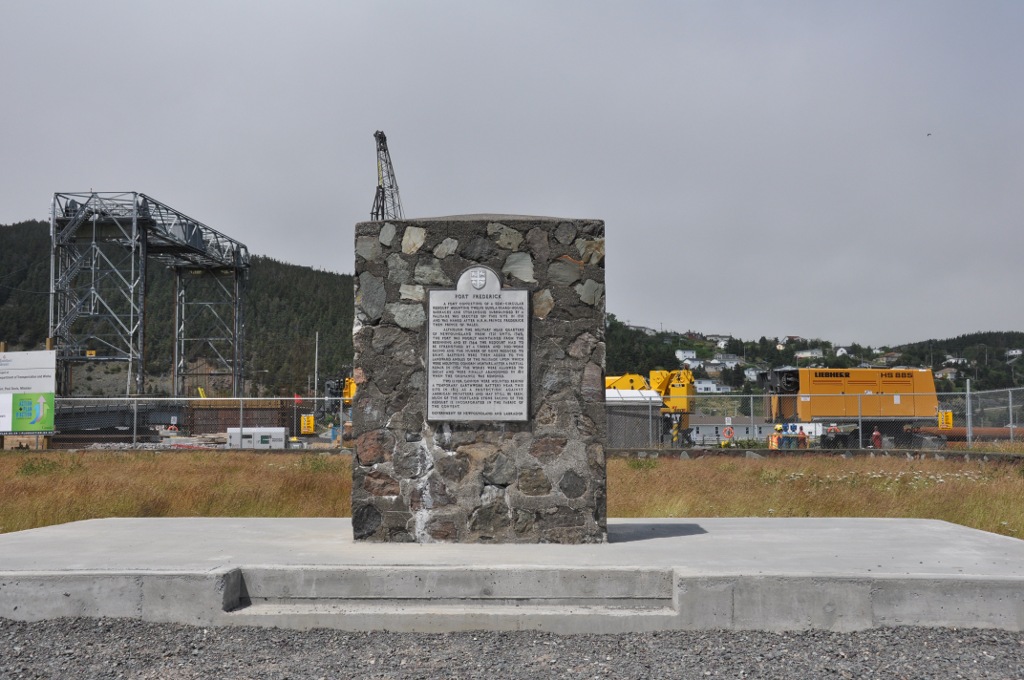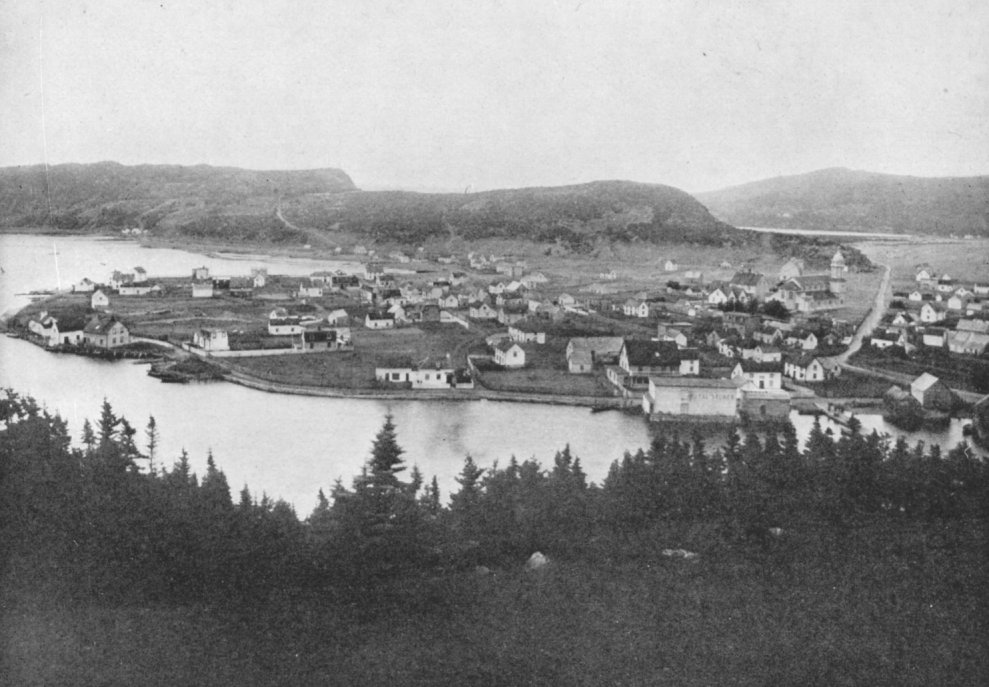|
Fort Frederick (Newfoundland)
Fort Frederick was a British redoubt that was built to help fortify their acquisition of Placentia in Newfoundland Colony. Under the command of Samuel Gledhill, it served as the military headquarters for Newfoundland from 1721 to 1746. There was a report that the Mi'kmaq were involved in a raid of Placentia during Father Rale's War, in which they were said to have killed 200 English. Governor Drummer did not believe the report. By the 1740s, the British began construction of New Fort, which overlay the former Fort Louis. During King Georges War, the Mi’kmaq militia from Ile Royal raided various British outposts in Newfoundland in August 1745. They attacked several British houses, taking 23 prisoners. The following spring the Mi’kmaq began to take 12 of the prisoners to a rendez-vous point close to St. John’s, en route to Quebec. The British prisoners managed to kill their Mi’kmaq captors at the rendez-vous site near St. John. Two days later, another group of Mi� ... [...More Info...] [...Related Items...] OR: [Wikipedia] [Google] [Baidu] |
Redoubt
A redoubt (historically redout) is a fort or fort system usually consisting of an enclosed defensive emplacement outside a larger fort, usually relying on earthworks, although some are constructed of stone or brick. It is meant to protect soldiers outside the main defensive line and can be a permanent structure or a hastily constructed temporary fortification. The word means "a place of retreat". Redoubts were a component of the military strategies of most European empires during the colonial era, especially in the outer works of Vauban-style fortresses made popular during the 17th century, although the concept of redoubts has existed since medieval times. A redoubt differs from a redan in that the redan is open in the rear, whereas the redoubt was considered an enclosed work. The advent of mobile warfare in the 20th century diminished the importance of stationary defence positions and siege warfare. Historically important redoubts English Civil War During the English Civ ... [...More Info...] [...Related Items...] OR: [Wikipedia] [Google] [Baidu] |
Placentia, Newfoundland And Labrador
Placentia is a town located in the Canadian province of Newfoundland and Labrador. It consists of the Argentia Industrial Park and amalgamated communities of Townside, Freshwater, Dunville, Southeast, Point Verde and Jerseyside. History There is considerable evidence that Placentia Bay was intermittently occupied by Little Passage people.I. Marshall, ''A History and Ethnography of the Beothuk'' (Montréal: McGill-Queens University Press, 2014): 273. Their descendants, the Beothuk, continued to settle there until the 17th century. Remnants of Beothuk occupation from the surrounding area has been carbon dated back to as far as 1500 CE. Whether the Beothuk had come to permanently settle or just to fish has proved difficult to ascertain. By the late 17th century, the English and French settlers and fishermen had claimed the bays of Placentia.Newfoundland and Labrador Heritage Web Site, accessed March 5, 2019Disappearance of the Beothuk/ref> This effectively cut the natives off fro ... [...More Info...] [...Related Items...] OR: [Wikipedia] [Google] [Baidu] |
Newfoundland Colony
Newfoundland Colony was an English and, later, British colony established in 1610 on the island of Newfoundland off the Atlantic coast of Canada, in what is now the province of Newfoundland and Labrador. That followed decades of sporadic English settlement on the island, which was at first seasonal, rather than permanent. It was made a Crown colony in 1824 and a Dominion in 1907. Its economy collapsed during the Great Depression of the 1930s, and Newfoundland relinquished its dominion status, effectively becoming once again a colony governed by appointees from the Colonial Office in Whitehall in London. In 1949, the colony voted to join Canada as the Province of Newfoundland. History Indigenous people like the Beothuk (known as the ''Skræling'' in Greenlandic Norse), and Innu were the first inhabitants of Newfoundland and Labrador. During the late 15th century, European explorers like João Fernandes Lavrador, Gaspar Corte-Real, John Cabot, Jacques Cartier and others bega ... [...More Info...] [...Related Items...] OR: [Wikipedia] [Google] [Baidu] |
Samuel Gledhill (Governor)
Samuel Gledhill (7 April 1677 - 1735 or 1736) was the lieutenant-governor of Placentia, Newfoundland from 1719-c.1730. He was born at Horbury, near Wakefieid, Yorkshire, the youngest of the 13 children of Robert Gledhill, a cloth-dresser and educated at Wakefield Grammar School. He joined the navy but was kidnapped in Spain to be sold as a slave in the West Indies. After gaining his freedom he made his way to Spain and was commissioned a lieutenant in 1702 and promoted to lieutenant-colonel in 1707. He served in England and in the Low Countries, was wounded and taken prisoner at the Siege of Douai and subsequently freed in a prisoner exchange. In 1710 he lost a bid to be elected to Parliament for Carlisle and hotly contested the result to no avail. In 1712 he was made lieutenant-governor of Carlisle, with the rank of captain, in what later became the 11th (North Devonshire) Regiment of Foot. That same year he was the subject of affiliation proceedings in London's Westminster S ... [...More Info...] [...Related Items...] OR: [Wikipedia] [Google] [Baidu] |
Mi'kmaq
The Mi'kmaq (also ''Mi'gmaq'', ''Lnu'', ''Miꞌkmaw'' or ''Miꞌgmaw''; ; ) are a First Nations people of the Northeastern Woodlands, indigenous to the areas of Canada's Atlantic Provinces and the Gaspé Peninsula of Quebec as well as the northeastern region of Maine. The traditional national territory of the Mi'kmaq is named Miꞌkmaꞌki (or Miꞌgmaꞌgi). There are 170,000 Mi'kmaq people in the region, (including 18,044 members in the recently formed Qalipu First Nation in Newfoundland.) Nearly 11,000 members speak Miꞌkmaq, an Eastern Algonquian language. Once written in Miꞌkmaw hieroglyphic writing, it is now written using most letters of the Latin alphabet. The Mi'kmaq, Maliseet, and Pasamaquoddy nations signed a series of treaties known as the Covenant Chain of Peace and Friendship Treaties with the British Crown throughout the eighteenth century; the first was signed in 1725, and the last in 1779. The Miꞌkmaq maintain that they did not cede or give up their land t ... [...More Info...] [...Related Items...] OR: [Wikipedia] [Google] [Baidu] |
Father Rale's War
Dummer's War (1722–1725) is also known as Father Rale's War, Lovewell's War, Greylock's War, the Three Years War, the Wabanaki-New England War, or the Fourth Anglo-Abenaki War. It was a series of battles between the New England Colonies and the Wabanaki Confederacy (specifically the Miꞌkmaq, Maliseet, Penobscot, and Abenaki), who were allied with New France. The eastern theater of the war was located primarily along the border between New England and Acadia in Maine, as well as in Nova Scotia; the western theater was located in northern Massachusetts and Vermont at the border between Canada (New France) and New England. During this time, Maine and Vermont were part of Massachusetts.The Nova Scotia theater of the Dummer War is named the "Mi'kmaq-Maliseet War". John Grenier. ''The Far Reaches of Empire: War in Nova Scotia 1710-1760''. University of Oklahoma Press. 2008. The root cause of the conflict on the Maine frontier concerned the border between Acadia and New England, whic ... [...More Info...] [...Related Items...] OR: [Wikipedia] [Google] [Baidu] |
King Georges War
King George's War (1744–1748) is the name given to the military operations in North America that formed part of the War of the Austrian Succession (1740–1748). It was the third of the four French and Indian Wars. It took place primarily in the British provinces of New York, Massachusetts Bay (which included Maine as well as Massachusetts at the time), New Hampshire (which included Vermont at the time), and Nova Scotia. Its most significant action was an expedition organized by Massachusetts Governor William Shirley that besieged and ultimately captured the French fortress of Louisbourg, on Cape Breton Island in Nova Scotia, in 1745. In French, it is known as the ''Troisième Guerre Intercoloniale'' or Third Intercolonial War. The Treaty of Aix-la-Chapelle ended the war in 1748 and restored Louisbourg to France, but failed to resolve any outstanding territorial issues. Causes The War of Jenkins' Ear (named for a 1731 incident in which a Spanish commander sliced off the ear ... [...More Info...] [...Related Items...] OR: [Wikipedia] [Google] [Baidu] |
Military History Of The Mi’kmaq People
A military, also known collectively as armed forces, is a heavily armed, highly organized force primarily intended for warfare. It is typically authorized and maintained by a sovereign state, with its members identifiable by their distinct military uniform. It may consist of one or more military branches such as an army, navy, air force, space force, marines, or coast guard. The main task of the military is usually defined as defence of the state and its interests against external armed threats. In broad usage, the terms ''armed forces'' and ''military'' are often treated as synonymous, although in technical usage a distinction is sometimes made in which a country's armed forces may include both its military and other paramilitary forces. There are various forms of irregular military forces, not belonging to a recognized state; though they share many attributes with regular military forces, they are less often referred to as simply ''military''. A nation's military may ... [...More Info...] [...Related Items...] OR: [Wikipedia] [Google] [Baidu] |
Fort Frederick Newfoundland Blueprint
A fortification is a military construction or building designed for the defense of territories in warfare, and is also used to establish rule in a region during peacetime. The term is derived from Latin ''fortis'' ("strong") and ''facere'' ("to make"). From very early history to modern times, defensive walls have often been necessary for cities to survive in an ever-changing world of invasion and conquest. Some settlements in the Indus Valley civilization were the first small cities to be fortified. In ancient Greece, large stone walls had been built in Mycenaean Greece, such as the ancient site of Mycenae (famous for the huge stone blocks of its 'cyclopean' walls). A Greek '' phrourion'' was a fortified collection of buildings used as a military garrison, and is the equivalent of the Roman castellum or English fortress. These constructions mainly served the purpose of a watch tower, to guard certain roads, passes, and borders. Though smaller than a real fortress, they ... [...More Info...] [...Related Items...] OR: [Wikipedia] [Google] [Baidu] |
French And Indian War
The French and Indian War (1754–1763) was a theater of the Seven Years' War, which pitted the North American colonies of the British Empire against those of the French, each side being supported by various Native American tribes. At the start of the war, the French colonies had a population of roughly 60,000 settlers, compared with 2 million in the British colonies. The outnumbered French particularly depended on their native allies. Two years into the French and Indian War, in 1756, Great Britain declared war on France, beginning the worldwide Seven Years' War. Many view the French and Indian War as being merely the American theater of this conflict; however, in the United States the French and Indian War is viewed as a singular conflict which was not associated with any European war. French Canadians call it the ('War of the Conquest').: 1756–1763 The British colonists were supported at various times by the Iroquois, Catawba, and Cherokee tribes, and the French ... [...More Info...] [...Related Items...] OR: [Wikipedia] [Google] [Baidu] |
Thomas Graves, 1st Baron Graves
Admiral Thomas Graves, 1st Baron Graves, KB (23 October 1725 – 9 February 1802) was a British officer of the Royal Navy and a colonial official. He served in the Seven Years' War and the American War of Independence. He was also the Commodore-Governor of Newfoundland for a period of time.Article by Kenneth Breen, ‘Graves, Thomas, first Baron Graves (1725–1802)’, Oxford Dictionary of National Biography, Oxford University Press, Sept 2004; online edn, Jan 2008; Retrieved 4 June 2008 Military career Born in England in October 1725, Graves was the second son of Rear-Admiral Thomas Graves of Thanckes in |

.png)




